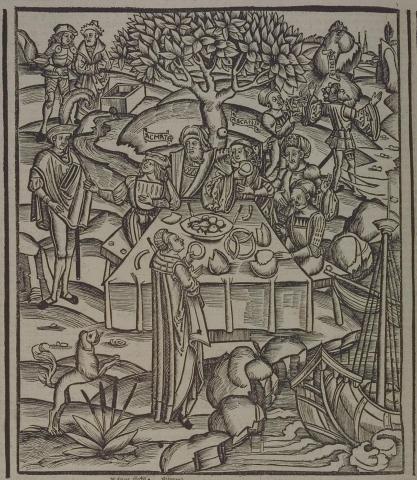Annotations
The men of Aeneas's fleet sit down at a table for a feast. Achates and Ascanius sit at the head of the table. The food at the table includes a bowl of what looks like pears, a few pretzels and a couple loaves of bread. Achates and another feaster have taken bites out of their bread. This is an extremely loose interpretation of the scene presented by Vergil. In Vergil's version, the members of Aeneas's party use flattened pieces of bread as tables, and once they eat all the food on their bread-plates, they eat the plates themselves. This fulfills a prophecy made by Aeneas's father, and signals that they have found their new land (107-29). In the background to the right, Aeneas makes a gesture of praise toward the gods (130-47), while an attendant holds a celebratory wreath.
Woodcut illustration from the “Strasbourg Vergil,” edited by Sebastian Brant: Publii Virgilii Maronis Opera cum quinque vulgatis commentariis expolitissimisque figuris atque imaginibus nuper per Sebastianum Brant superadditis (Strasbourg: Johannis Grieninger, 1502), fol. 291v, executed by an anonymous engraver under the direction of Brant.


Sebastian Brant (1458-1521) was a humanist scholar of many competencies. Trained in classics and law at the University of Basel, Brant later lectured in jurisprudence there and practiced law in his native city of Strasbourg. While his satirical poem Das Narrenschiff won him considerable standing as a writer, his role in the transmission of Virgil to the Renaissance was at least as important. In 1502 he and Strasbourg printer Johannes Grüninger produced a major edition of Virgil’s works, along with Donatus’ Life and the commentaries of Servius, Landino, and Calderini, with more than two hundred woodcut illustrations. (Annabel Patterson)